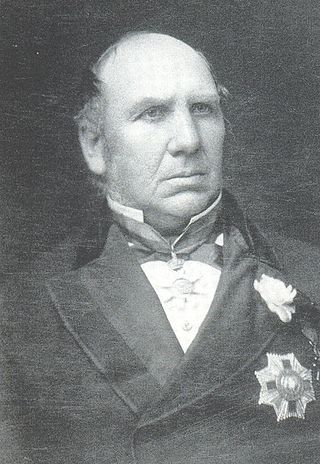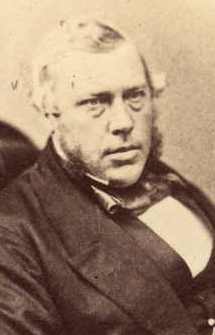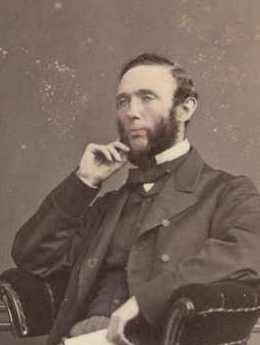
Field Marshal Colin Campbell, 1st Baron Clyde,, was a British Army officer. After serving in the Peninsular War and the War of 1812, he commanded the 98th Regiment of Foot during the First Opium War and then commanded a brigade during the Second Anglo-Sikh War. He went on to command the Highland Brigade at the Battle of Alma and with his "thin red line of Highlanders" he repulsed the Russian attack on Balaclava during the Crimean War. At an early stage of the Indian Mutiny, he became Commander-in-Chief, India and, in that role, he relieved and then evacuated Lucknow and, after attacking and decisively defeating Tatya Tope at the Second Battle of Cawnpore, captured Lucknow again. Whilst still commander-in-chief he dealt with the "White Mutiny" among East India Company troops, and organised the army sent east in the Second Opium War.

Sir James McCulloch, was a British colonial politician and statesman who served as the fifth premier of Victoria over four non-consecutive terms from 1863 to 1868, 1868 to 1869, 1870 to 1871 and 1875 to 1877. He is the third longest-serving premier in Victorian history.

William Clark Haines, Australian colonial politician, was the first Premier of Victoria.

Sir John O'Shanassy, KCMG, was an Irish-Australian politician who served as the 2nd Premier of Victoria. O'Shanassy was born near Thurles in County Tipperary, Ireland, the son of a surveyor, and came to the Port Phillip District in 1839. He went into business in Melbourne as a draper, and by 1846 he was rich enough to be elected to the Melbourne City Council and to become the founding chairman of the Colonial Bank of Australasia. By the 1850s he was a major landowner and one of the wealthiest men in the colony. He also became a recognised leader of the large Irish Catholic community.

William Nicholson was an Australian colonial politician who became the third Premier of Victoria. He is remembered for having been called the "father of the ballot" due to his responsibility in introducing the secret ballot in Victoria.

Sir Charles Sladen,, Australian colonial politician, was the 6th Premier of Victoria.

James Service, Australian colonial politician, was the 12th Premier of Victoria, Australia.

Sir Henry John Wrixon was an Australian barrister and politician.

Sir William Henry Fancourt Mitchell was an Australian police commissioner and politician, President of the Victorian Legislative Council for fourteen years.

Admiral Maurice Frederick FitzHardinge Berkeley, 1st Baron FitzHardinge, was a Royal Navy officer. As a junior officer he commanded gunboats on the Tagus, reinforcing the Lines of Torres Vedras, in Autumn 1810 during the Peninsular War and, as a captain, he served on the coast of Syria taking part in the capture of Acre in November 1840 during the Oriental Crisis. He also served as Whig Member of Parliament for Gloucester and became First Naval Lord in the Aberdeen ministry in June 1854 and in that role focussed on manning the fleet and in carrying out reforms and improvements in the food, clothing, and pay of seamen.

Sir Robert Molesworth was an Irish-born Australian Judge of the Supreme Court of Victoria and Solicitor-General.
The Bolte Ministry was the 58th Ministry of the Government of Victoria, and was led by Liberal Premier Sir Henry Bolte. It succeeded the Cain ministry on 7 June 1955, following the defeat of the Labor government at the 1955 election held ten days earlier. The ministry lasted over 17 years and was followed by the Hamer Ministry on 24 August 1972 after the resignation of Bolte from politics.
Thomas Howard Fellows was an English rower and an Australian politician and Judge of the Supreme Court of Victoria.

The Attorney-General of Victoria, in formal contexts also Attorney-General or Attorney General for Victoria, is a minister in the Government of Victoria, Australia. The Attorney-General is a senior minister in the state government and the First Law Officer of the State.
The Solicitor-General of Victoria, known informally as the Solicitor-General, is the state's Second Law Officer and the deputy of the Attorney-General. The Solicitor-General acts alongside the Crown Advocate and Crown Solicitor, and serves as one of the legal and constitutional advisers of the Crown and its government in the Australian state of Victoria.

Sir Archibald Michie, was an English-born Australian lawyer, journalist, Agent-General, Attorney-General of Victoria and politician.
William Acland Douglas Anderson, (31 October 1829 – 23 January 1882) was an English-born politician and goldfields commissioner in colonial Victoria, Australia.

This is a list of members of the Victorian Legislative Council, as appointed to the Council of 1853 or elected at the 1853 election. Members added in 1855 are noted in a separate section below.

James Ford Strachan was a merchant, grazier and politician in colonial Victoria, Australia, and a member of the Victorian Legislative Council.
Members of the New South Wales Legislative Council who served from 1856 to 1861 were appointed for a fixed term by the Governor on the advice of the Premier. The 1855 Constitution of New South Wales provided that the first council following self-government was for a period of 5 years from the first appointments, but that subsequent members would be appointed for life. The first appointments were on 13 May 1856 so that the first term lapsed on 13 May 1861. The number of members of the council had to be at least 21 and subsequent appointments also lapsed on 13 May 1861. The President was Sir Alfred Stephen until 28 January 1857, John Plunkett until 6 February 1858 and then Sir William Burton.














